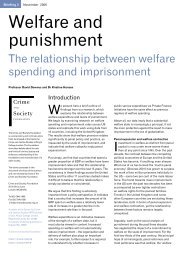PRISON SERVICE
PRISON SERVICE
PRISON SERVICE
- No tags were found...
Create successful ePaper yourself
Turn your PDF publications into a flip-book with our unique Google optimized e-Paper software.
infectious diseases such as HIV, the findings aresurprisingly similar in locating the problem in contextualfactors which in turn influence individual risks. Alarid 16carried out a study of nearly 200 correctional officers in aUS Midwestern state and found that it was institutionalvariables rather than individual behaviour that predictedexposure to HIV. It is important to note that HIV hereserves as an exemplar infectious disease, since it istransmitted through blood and other body fluids, as arehepatitis B and C, both of which are very prevalent inprison populations, both an order of magnitude moreinfectious than HIV, and both may have severe orpotentially fatal consequences. Alarid notes that prisonstaff are likely to be first responders to physicalaltercations, accidents, medical emergencies, andunpredictable and often hostile situations where sharpobjects and body fluids may present risks. In addition,prison staff may frequently come into contact withneedles discarded by inmates who don’t have access toneedle exchange or drug treatment, or from prisontattooing practices. Alarid notes that a number ofinstitutional variables are likely to increase risk, includinghigher prisoner security level units, afternoon and eveningshifts when there is more misconduct on the part ofprisoners, and length of time employed in the correctionalsystem.Alarid’s data confirm that institutional and contextualvariables (perhaps through their influence on individualrisk) are among the best predictors of occupationalexposure to blood-borne pathogens such as HIV. Thecustody level of inmates (a measure of the level ofviolence), length of employment (a measure of thecumulative level of exposure to risk situations), and rank(which reflects the risk of being called to medicalemergencies and altercations) all predicted level ofexposure to blood-born pathogens. Interestingly, in termsof the prisoner variables that impacted on the risk ofexposure for custodial staff, the sex of prisoners was nota significant risk, but prisoner behaviour (injecting druguse, tattooing, security level, and (for males) inmateinmatesex) all presented the greatest risk of HIV infectionand thus the greatest potential threat to prison staff.What is important to note in both Armstrong andGriffin’s 17 and Alarid’s work is that institutional andorganizational variables may be strongly associated withhealth status or risks in correctional settings. The risks ofcontracting infections such as HIV and hepatitis B and Care obviously dependent on the prevalence of theseconditions in the inmate population, but also oncontextual and institutional factors: the institutional-levelprobability of exposure events, such as needle sticks orother forms of exposure to inmate blood and other bodyfluids, and the individual-level probability of directexposure, given the individual’s role in the institution. Thehealth of prison staff, therefore, needs to be understoodnot only in terms of the immediate risk situation, but alsoin terms of the organizational and institutional factorsthat focus that risk, and may also create some of thestressors that are associated with longer-term chronicdisease in correctional staff.Inmate and Prison Staff Health InteractionsTaken together, these data suggest that there are anumber of significant relationships between the health ofinmates and of prison staff, and that prison environmentaland organizational issues may also play an important rolein the health of custodial staff, particularly over the longterm.Interestingly, the pattern also holds with blood-borninfectious diseases, suggesting that the concept of riskenvironments, as much as risk sources and behaviours,needs to be considered. In particular, the long-term healthconsequences of working in a custodial environment (andthe role of stress and environment) need to be betterstudied. However, any distinction between inmate healthand custodial staff health, either short-term or long-term,is likely to be arbitrary. For a number of important healthissues in custodial environments, there is little distinctionbetween inmate and free, and the concept of a healthyprison needs to embrace both inmate and staff health asintegral to one another.16. Alarid LF (2009). Risk factors for potential occupational exposure to HIV: A study of correctional officers. Journal of Criminal Justice37:114-122.17. Armstrong GS, Griffin ML (2004). See n.4.Issue 192 Prison Service Journal59











